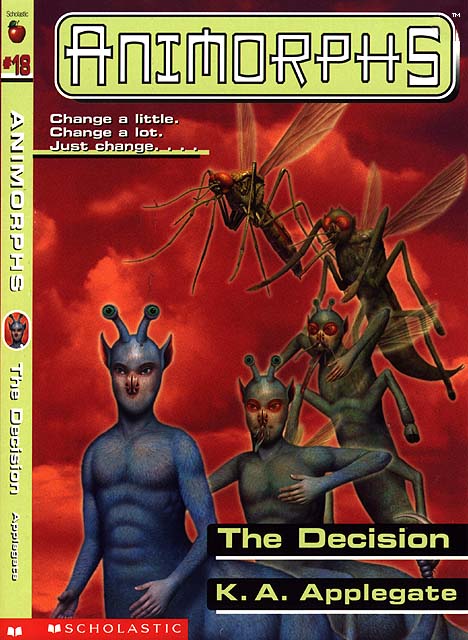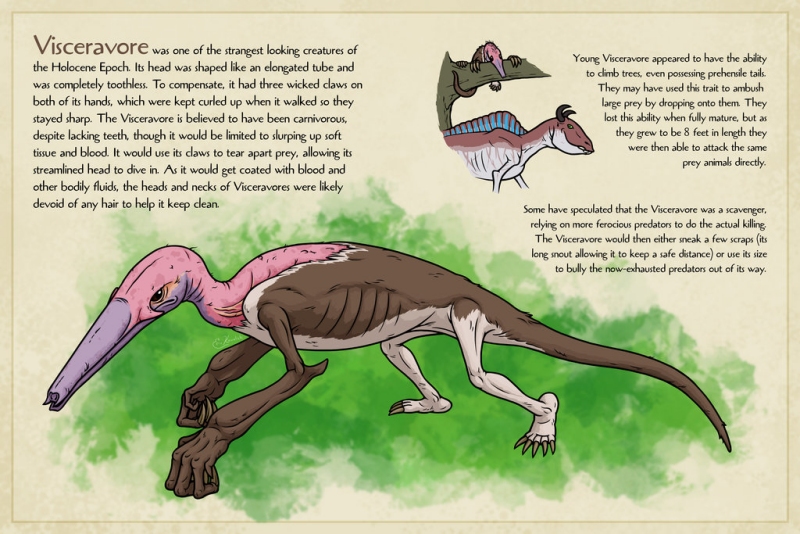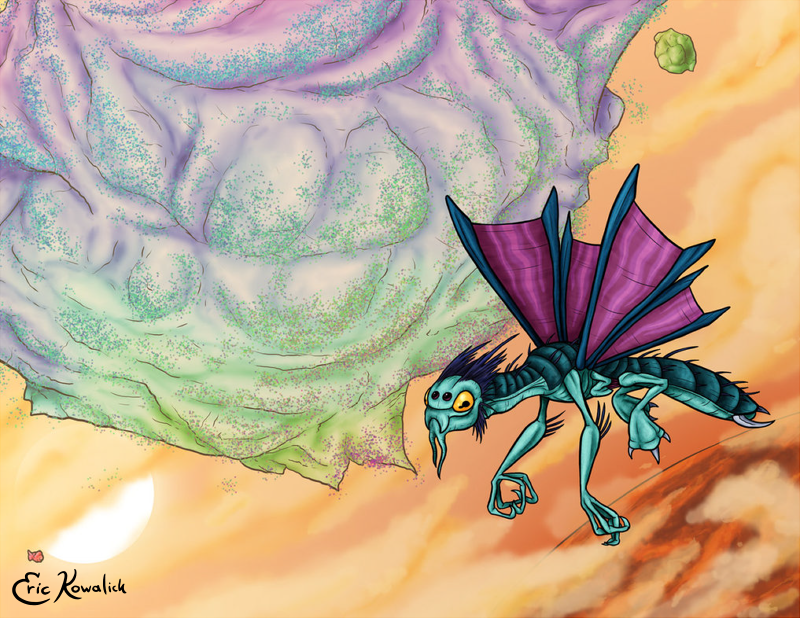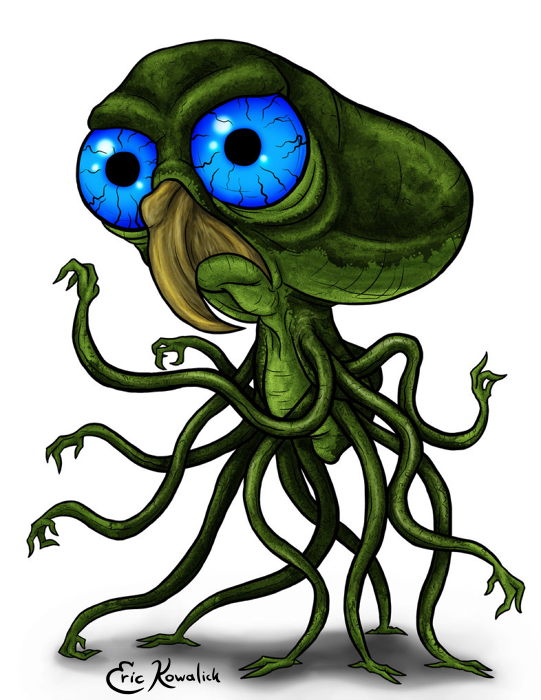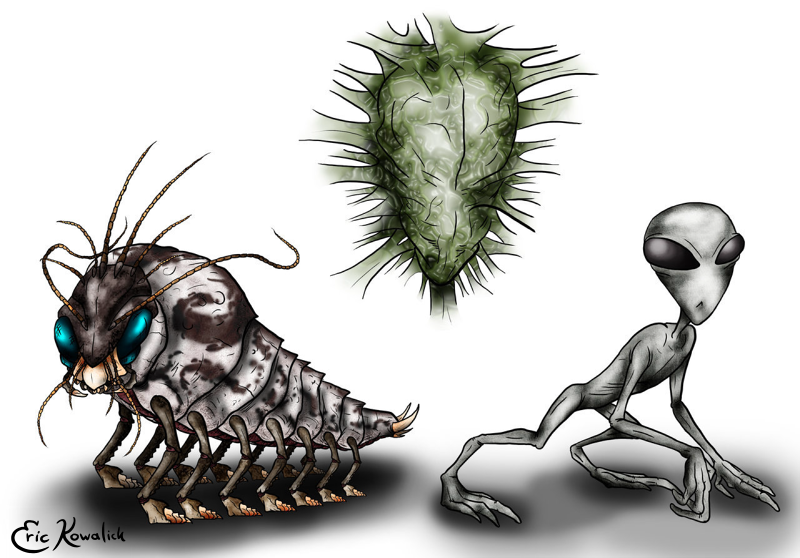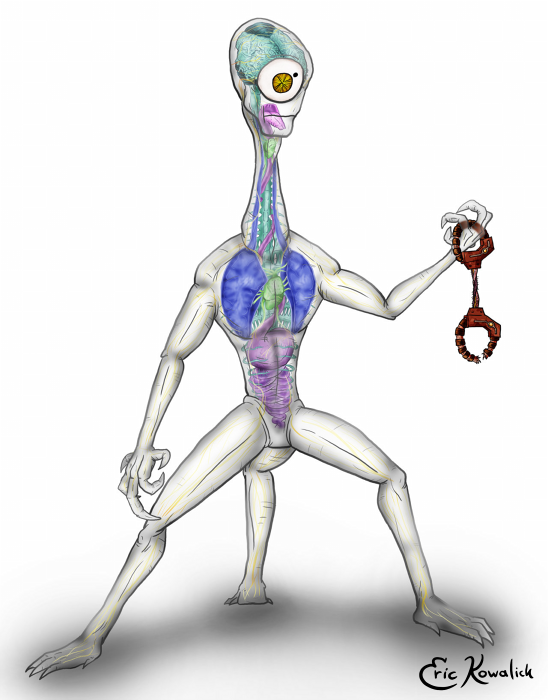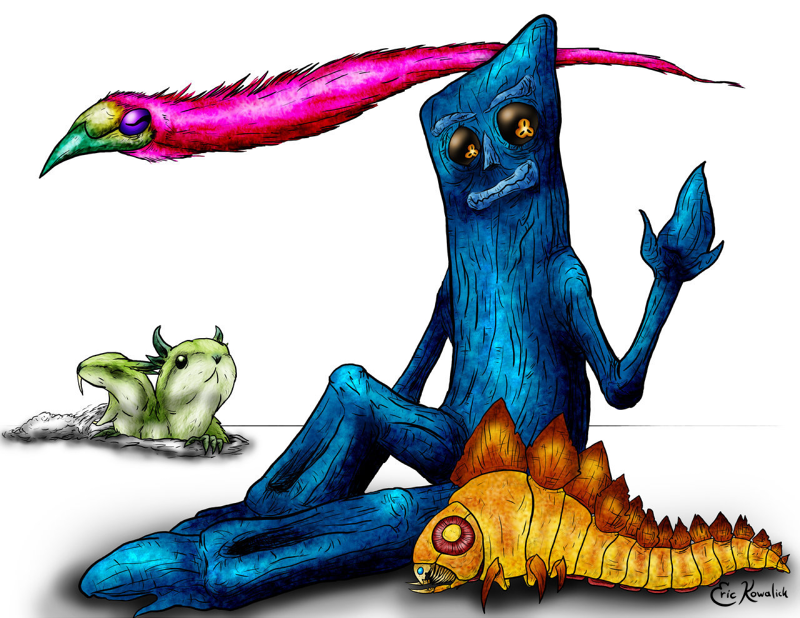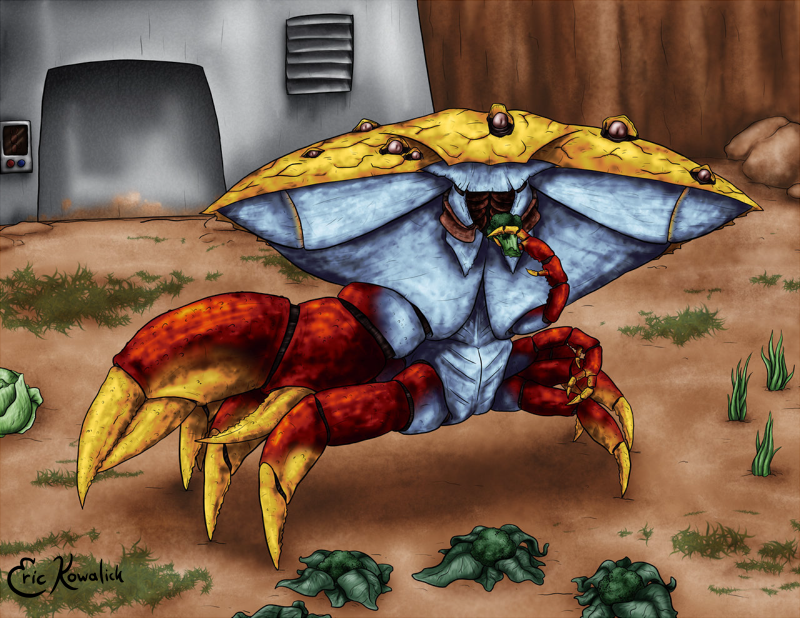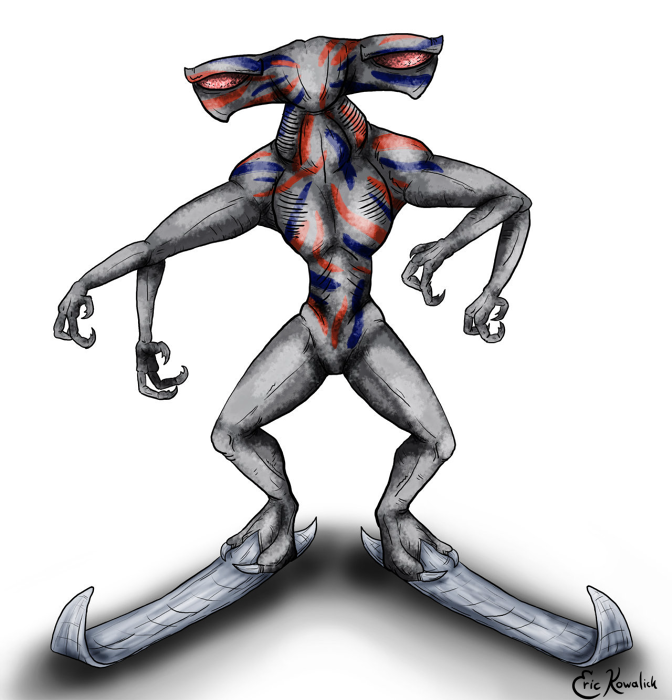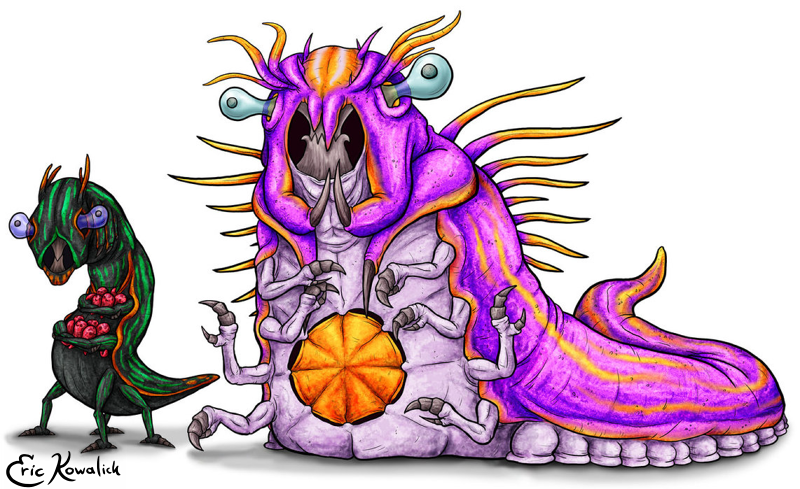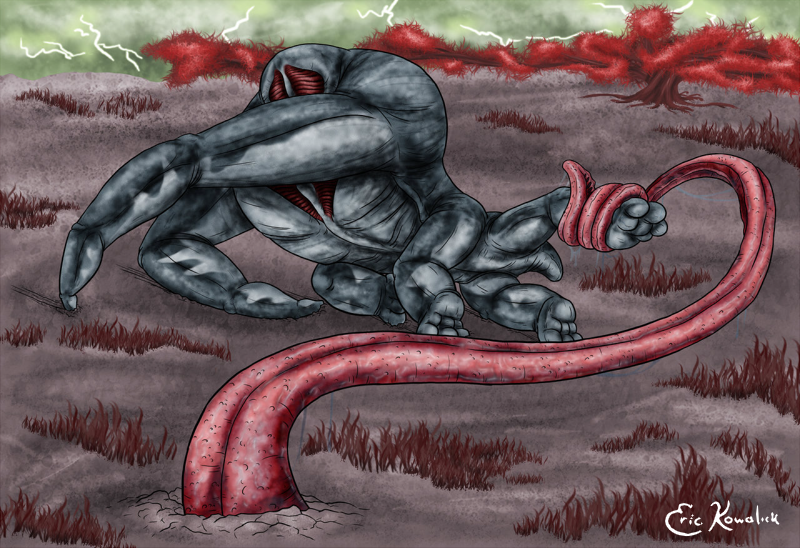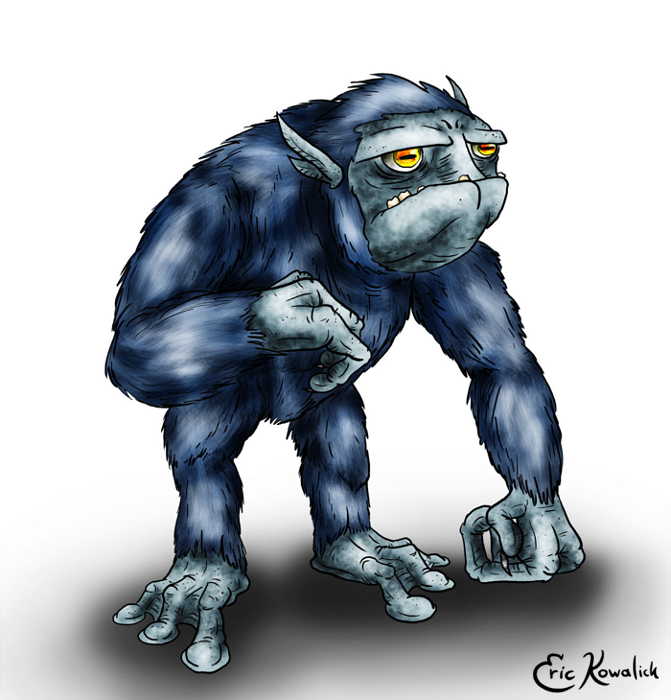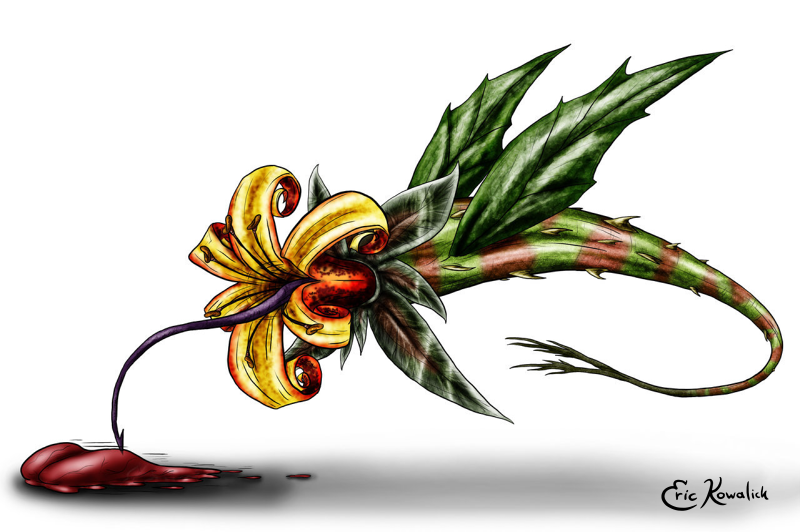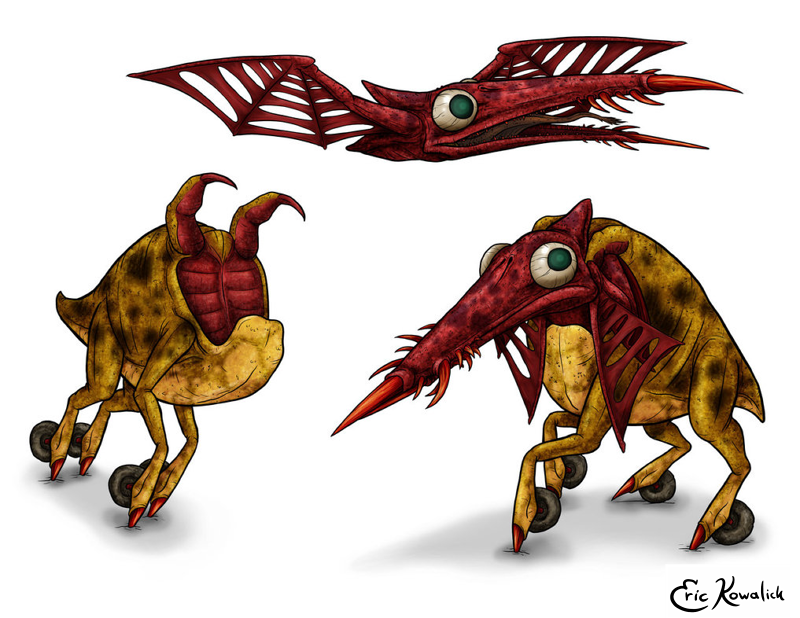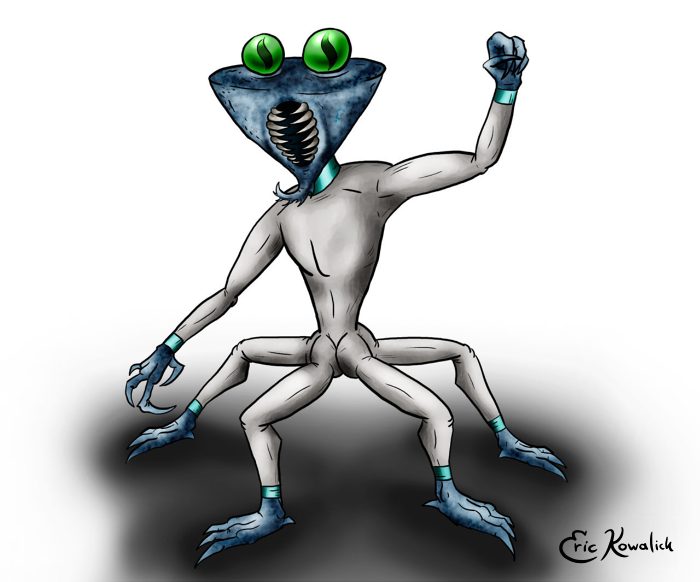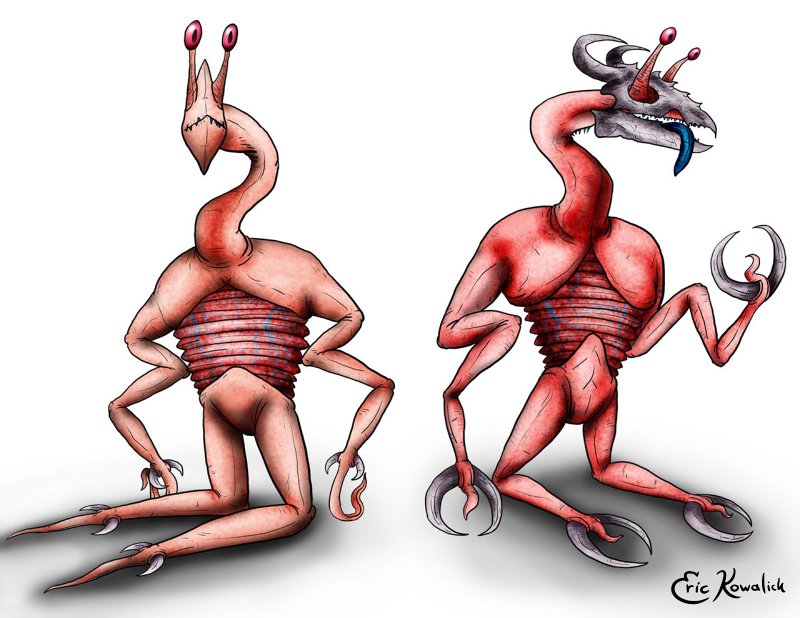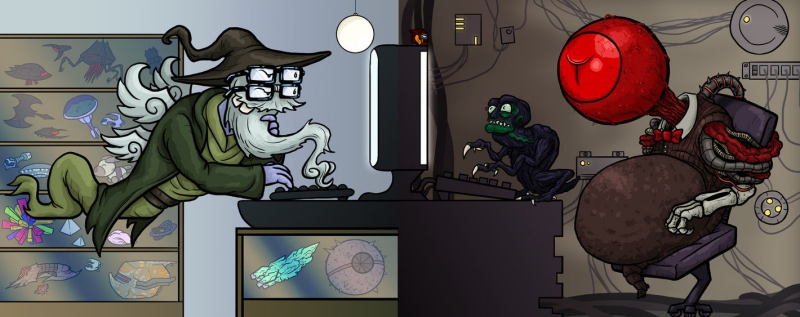Previously, we talked about the many brands of horror offered by K.A. Applegates animorphs. Existential horror, body horror, cosmic horror, Animorphs has it all...and there's still more! We've already seen that the series offers some positively killer ideas for life on other planets, and we're going to take a look at even more of them here!
Before we begin though, please pay a visit to Eric Kowalick's website. This article wouldn't be possible if he hadn't been nice enough to let me use illustrations he did about a million years ago, and the complete Animorphs bestiary is nothing compared to the scope of his original creatures designs, speculative paleobiology and more! If you've read a lot of Bogleech already, you may remember his illustrations of "real" alien encounters, and he's done quite a few more of those, to boot!
The Xenobiology of Animorphs
The Ketran
We're going to begin with what would ultimately be one of the most important races in the series, so, spoiler alerts I guess. We talked in our last article about the Ellimist, one of two virtually god-like entities who have spent eons using countless civilized planets as pawns in their own bitter rivalry. We learn the origin of the relatively benevolent Ellimist in his own stand-alone novel, and that he was once a very, very different creature called a Ketran.Ketrans are never described in complete detail, but we know that they have four wings, four eyes and six limbs, maybe bird-like, maybe insect-like. In a bit of foreshadowing, their culture focuses heavily on electronic games in which they manipulate the evolutionary course of simulated planets, basically playing a much more advanced, hyper-realistic version of Spore.
The glimpses we're given into the psychology of these creatures is especially novel. For millions of years, they've lived in tremendous numbers on the outside of floating, crystalline structures held aloft and steered in part by their collective wings. This lifestyle renders the entire species hopelessly claustrophobic, to the point that one minute in an enclosed space feels like a fate worse than death. The result is some of the most impractical, ridiculous spacefaring technology you could ever imagine, with Ketran crews clinging to the exteriors of "inside-out" starships and only an invisible force field for protection. The thought of intelligent extraterrestrials hampered by a universal phobia of the indoors seems ridiculous, but who knows how many human behaviors might seem equally laughable to the eyes of some other species.
The Capasin
We never learn too much about the Capasin, except for a vivid description of cephalopoidal organisms with scowling, hooked beaks and gigantic, bulging eyeballs, similar in many respects to the Martians described by H.G. Wells, and like the Martians, they invade an unsuspecting world with a devastating attack. The homeworld of the Ketran, to be precise...but are they just hateful, violent invaders?In typical Animorphs fashion, nothing is ever as simple as it seems. Having picked up transmissions of Ketran simulation games, the Capasin are convinced that the bird-bugs are actually toying with the lives of actual planets, and they take it upon themselves to save the galaxy from this horrific menace before any more worlds are reduced to playthings.
Tragically, this misunderstanding would remain unresolved. The communication barrier between Ketran and Capasin was simply too great, and the Ketran were eradicated down to just a few refugees. Could we be next? Are aggressive Xbox Live players destined to seal our doom the same way?
The Skrit-Na
So if aliens are real, does that mean all those cattle mutilations, crop circles and butt-probings are real?As it turns out, yes, but the truth isn't nearly as glamorous as UFOlogists have so long speculated. The grey-skinned humanoids we're so intimately familiar with are the "Na," the adult stage of a mindless, silverfish-like "Skrit," and they're little more than a sleazy, unscrupulous race of scavengers and swindlers. They traverse the galaxy collecting anything that isn't nailed down - including scientific data - just to sell and trade to whatever other races might find a use for it.
Even this isn't the reason they abduct humans and deface cornfields, though.
That's just when they're really bored.
The Orff
Orff are encountered by the Animorphs only in a hypothetical, alternative future where the Yeerks have successfully conquered the planet Earth, and these bizarre, fast-talking host bodies are employed by the parasites as an elite police force.An Orff's skin is naturally crystal clear, but it can change coloration and become completely invisible except for the dim glow of its single, huge eyeball. Absurdly, the pupil of the eye is endlessly circling around what should be the iris, and we're never offered explanation for this nonsensical anatomical quirk.
It's also speculated that the colorful, visible organs of an Orff are merely "decoy" organs, and their true vital points are hidden away in less obvious locations.
Graffen's Children
In the previous article, we talked about the Howlers, a murderous artificial race in service to Crayak. Howlers are responsible for the complete and total genocide of countless other races, and the Animorphs are treated to vivid, terrifying memories of just one such encounter.We know nothing about the beings called "Graffen's Children" except that they lived in harmony with their planet's many animals, named themselves after some sort of god-figure, had utterly no concept of violence and looked amazingly like Gumby if he were bright blue and made of tree bark. When the Howler's arrived on their planet, the awkward blue beings greeted them with open arms - only to be blasted apart by the physical force of the Howler's sonic cries.
The Mercora
The Mercora are featured in a stand-alone "Megamorphs" book in which the Animorphs fulfill every child's dream of travelling back to the age of the dinosaurs. There, they encounter asymmetrical, many-eyed, peaceful crab-like aliens who apparently colonized our planet over 60,000,000 years ago, bringing with them crops that would become many modern vegetables - including brocolli - and their ant-like arch enemies, the Nesk.The Mercora are completely peaceful creatures, but are destined to be destroyed by the same meteor strike that would doom the nonavian dinosaurs.
This actually brings us to yet another of the series many existential tragedies, as the Animorphs are given an opportunity to stop that very meteoric impact. This, of course, would prevent the evolution of the human race and all modern life as we know it, so it seems like a no-brainer...but the kids have to live with the knowledge that they have, in a sense, participated in the genocide of these peaceful creatures. What can you do, when you're forced to choose between your own species and another?
The Venber
Adapted to life on an ice cold moon, the Venber have ski-like feet and an imperviousness to cold...but melt into liquid at anything above freezing. This liquid state proves useful to the technology of other civilized beings, and the Venber are driven to extinction until resurrected by the Yeerks here on Earth, even incorporating some human DNA.Too cold to be infested by live Yeerks, the cloned Venber are instead enslaved by electronic implants, and forced to pursue the Animorphs even into warm environments...their bodies oozing and dribbling away to nothing even as they shamble onward against their will.
Sorry, this article wasn't supposed to be just another horrorfest, but that's what you get with Animorphs.
The Jallians
Early in the Ellimist's life as a quasi-god, he encounters two neighboring races at war with one another for unspecified reasons. One, the "Inner Worlders," resemble bird-winged creatures with multiple eyes. The other, the Jallians, are many-limbed slugs ruled by their fertile females, who give birth continuously from a ring of ventral slits. The Inner Worlders speak politely, but show incredible hostility, while the Jalliens - or at least the ruling mother the Ellimist encounters - are merely loud-mouths with a superiority complex.The Ellimist attempts to end their war by creating an asteroid barrier between the two planets, but the Inner Worlders ultimately launch enough nuclear arms to break through and completely exterminate the poor Jalliens. Left with nothing to do, the dumb birds turn on one another and drive themselves back to the dark ages.
The Yeerk Homeworld Tongue Creature
This is a pretty minor one, but when we finally get a description of the Yeerk home planet, it's largely devoid of life outside the bubbling Yeerk pools. All except for some weird, "headless" bull-sized creatures and something that lives under the ground, reaching out with nothing but a massive, tentacular tongue to ensnare passing prey.The Gedd
Speaking of the Yeerk planet, it's a little disappointing that we don't learn much about the Gedd, the pitiful native species traditionally used by the Yeerks as hosts. The squat, wrinkled, apelike humanoids aren't very smart, can barely articulate words even with a Yeerk in control, and for no known reason, their legs are very slightly different lengths. Just different enough that it's difficult for a Gedd to walk without supporting itself on one arm.The Gedd are so pitiful, receive so little respect and are mentioned so rarely that I'd have fully expected them to factor in some grand, final plot twist...that perhaps the Gedd were smarter than we thought, or held the true key to the Yeerk's defeat. Alas, if the limping monkeys had any story to tell, they didn't get a good chance to share it before a bunch of Earth kids saved the universe without them.
The Blob-Sucking Plant
This one is a little hard to explain, but to keep it as simple as possible, there's a scene in which Crayak sets up a fight between the villain Visser Three and one of the Animorphs. Visser three, known for collecting horrific morphs from across the galaxy, takes on the form of an all-consuming gelatinous slime. Rachel, in response, is allowed to morph an organism perfectly suited to counter this form, a winged plant with a hummingbird-like proboscis and an appetite for ambulatory ooze.Whether this is a unique, original being manifested by Rachel or the actual natural predator of the Visser's blob morph isn't clear, but a gigantic plant that "drinks" carnivorous blobs is still one of the most amazing creature concepts I've probably ever heard.
The Mortrons
The Mortons might be my favorite concept and design in the series. A pair of them named "Jarex" and "Larex" are encountered as "pets" of the power-mad Yeerk Esplin 9466, who would later become Visser Three, main antagonist of the series.Mortrons aren't content with being only one kind of weird. They have organic wheels, their heads can fly separately from their bodies, and enough physical damage will only multiply them - like a starfish. Unfortunately, their planet is said to have been destroyed when its sun went nova, and Jarex and Larex don't survive their first and only appearance. We can't be certain there weren't any more Mortrons rolling around some other planet, but this is Animorphs after all. Extinction is one of its biggest running themes.
The Helmacrons
Almost tied for my favorite species in the series, the Helmacrons appear out of nowhere as the major antagonists of two books, and you know they're two of my favorites when half the fandom supposedly regards them as annoying "filler" material. These four-legged humanoids have toothy maws that open vertically, barbed hooks on their chins, and marble-like eyeballs resting atop perfectly flat scalps, they somehow exist without breathing whatsoever, and the females are much larger and more aggressive than their seldom-seen, apparently oppressed males... but you don't want to trust those guys, either.Most importantly, Helmacrons are barely any larger than fleas, but tell that to their fanatical egos. The little cuties are completely fearless, merciless conquerers with a bottomless lust for combat, they can't seem to say anything without screaming it and they never, ever shut up about their own perceived superiority to all other life. If you're even marginally familiar with Invader Zim, that's exactly what a Helmacron is. It's an entire race of just microscopic Zims. My wife read their dialog to me in his voice and I can't fathom them sounding any other way. They even talk about doom a lot, though IZ wouldn't premiere for a good 3-4 years after the Helmacrons first debuted.
The seemingly suicidal audacity of the Helmacrons is somewhat justified, as it turns out the species simply absorbs the mind of any individual Helmacron that ever dies. What effect this actually has beyond a total indifference toward death isn't clear, since they never seem to get any smarter and they continue to experience a sense of individuality...though every single one of them does display basically the same personality. Which came first? Were they always an entire race of screwball egomaniacs, or is that the inevitable result of their minds all gradually leaking into one another? Did something just go terribly wrong with that process? Could they have once been peaceful?
Whatever their past, the Helmacrons are so completely bonkers by the time we encounter them that they all follow the "commands" of a rotten corpse. A Helmacron simply can't trust another Helmacron enough to accept them in a leadership position, so the captain's chair of every Helmacron ship is occupied by a dead body, ritualistically stabbed through with a sword upon accepting such a high position. As long as they believe they share this "captain," a Helmacron crew can just barely work together under its imaginary orders to a startlingly effective degree.
The Iskoort
It's a crime against humanity that the Iskoort appear for only a single book; physically, culturally and psychologically, every single part of them is as weird and preposterous as can be.The basic Iskoort is distinguished by its triangular head, stalked eyes, long neck, multiple elbows, tentacle-pincer combo package, "backwards" legs it awkwardly shuffles upon, and an accordian-like midsections that emits an obnoxious, wheezing whine. Already, they're hilarious enough at face value, but it just gets better from there.
Iskoort society is a lot like our own if capitalism and beaurucracy ran even more amok. It's a ramshackle circus of self-serving "guilds" devoted to every societal role imaginable, from a "shopper's guild" that exists only to consume products, to a "warrior's guild" that starts entire wars for the simple sake of having wars to manage at all. Iskoort are even born into their respective guilds, and while we're not given the specifics, their bodies are genetically modified to better suit whether they're warrior, shopper, mystic or politician or door-to-door salesman.
It's especially unfortunate that we don't get a deeper look into Iskoort religious beliefs, since the one glimpse we're offered is the following dialog:
"The Worker's Guild refuses to come back to work until the Superstition and Magic Guild certifies that the place is free of the spirits of fictional characters" ..."The simple folk believe that fictional characters are at least partly real and thus have spirits who wander the city, infesting buildings and engaging in various destructive behaviors."
I would read an ENTIRE book about that. I would read an entire series about that. Also, did I mention that Iskoort architecture looks like hideously mis-matched, brightly colored lego blocks in nonsensical, messy clumps?
Though they seem like pure comic relief, things take a turn for the serious when we discover the true nature of these creatures: each one is actually two creatures, an "outer self" called an Isk, and an "inner self" called a Yoort. In other words, they are a species of brain parasites startlingly similar to the Yeerks, but the line between parasite and host has in this case become difficult to separate. The Iskoort essentially serve as a "what if?" in the Yeerk's conquest of the galaxy, a look at how the species could potentially give up its destructive ways and find itself at peace.
This has been only a partial look at the imaginatively varied aliens featured in Animorphs continuity, and didn't even begin to touch on the many gruesome morphs taken on by Visser Three, nor the abyssal monsters of the Hork-Bajir homeworld. Between its fun character writing, brilliant creature concepts and all that juicy, delicious nightmare fuel we talked about, you're probably long overdue to either finally read this series, or read it all over again.
And please don't forget to check out the artist who brought all these bozos to life, and has only grown into an even better illustrator in the years since.
